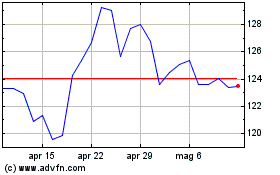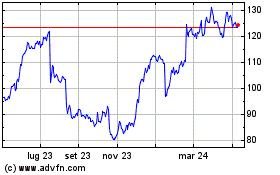Capital One Outpaces Estimates - Analyst Blog
14 Luglio 2011 - 2:30PM
Zacks
Capital One Financial Corp.’s (COF) second
quarter 2011 earnings from continuing operations of $2.04 per share
were substantially ahead of the Zacks Consensus Estimate of $1.67.
Though this compared unfavorably with $2.04 in the prior quarter,
it surpassed $1.78 recorded in the year-ago quarter.
Better-than-expected results for the quarter were primarily
aided by increased revenues and a lower provision for loan losses
ensuing from an improved credit performance. Additionally, the
company’s capital and profitability ratios also improved. However,
an increase in operating expenses was a downside.
Additionally during the quarter, Capital One announced an
agreement to acquire ING Direct USA, the online banking unit of
Amsterdam-based ING Groep NV (ING), in a
stock-cum-cash transaction valued at $9.0 billion. The acquisition
is expected to close late this year or early next year.
Quarter in Detail
Capital One’s net income from continuing operations was $945
million, down 8.4% from $1,032 million in the prior quarter but up
16.4% from $812 million in the year-ago quarter. Adjusting the loss
from discontinued operations, Capital One’s net income came in at
$911 million, or $1.97 per share, compared with $1,016 million, or
$2.21 per share, in the previous quarter and $608 million, or $1.33
per share, in the year-ago quarter.
Total revenue for the reported quarter stood at $3.99 billion,
down 2.2% sequentially but up 2.3% year over year.
Net interest income slipped 0.1% sequentially but inched up 1.3%
year over year to $3.14 billion. Similarly, non-interest income
also declined 9.0% sequentially but rose 6.2% year over year to
$857 million.
Net interest margin (NIM) decreased 4 basis points (bps)
sequentially but improved 11 bps on a year-over-year basis to
7.20%. The sequential drop was due to a 15 basis point fall in
earning asset yields, partially offset by a 13 basis
point improvement in cost of funds.
Capital One’s operating expenses for the reported quarter
climbed 2.1% sequentially and 8.4% year over year to $1.93 billion.
The increase was mainly due to a rise in salaries and associate
benefits expenses.
The managed efficiency ratio deteriorated to 56.47% from 52.96%
in the prior quarter and 51.23% in the prior-year quarter. The
increase in efficiency ratio indicates deterioration in
profitability.
Credit Quality
Capital One’s credit quality continued to improve during the
quarter. Allowance, as a percentage of reported loans held for
investment, fell 60 bps sequentially to 3.48%. Also, the net
charge-off rate dropped 75 bps sequentially to 2.91%, as a
continued improvement in credit led to charge-off improvements
across all business segments. The 30-plus day performing
delinquency rate also fell 17 bps sequentially to 2.9%.
Similarly, provision for loan and lease losses declined 35.8%
sequentially and 52.6% year over year to $534 million. The decrease
was driven by lower charge-offs in the reported quarter.
Capital and Profitability Ratios
Capital One’s capital and profitability ratios continued to
enhance during the quarter. Tangible common equity (TCE) ratio for
the quarter improved to 7.9% from 7.3% in the prior quarter and
7.1% in the year-ago quarter. Also, Tier 1 risk-based capital ratio
rose 70 bps sequentially to 11.6%.
The company’s tangible book value per share was $32.33 as of
June 30, 2011 compared with $29.70 as of March 31, 2011 and $24.89
as of June 30, 2010.
Peer Performance
One of the close peers of Capital One, Discover
financial Services (DFS) posted a solid second quarter,
reporting earnings substantially ahead of the Zacks Consensus
Estimate, driven by a lower loan loss provision and higher
transaction and credit card sales volumes, which also drove the
loan loss reserve release growth. In addition, higher consumer
spending and merchant acceptance also contributed to the
substantial expansion of income across the direct banking and
payment services segments.
Our Viewpoint
We anticipate continued synergies from Capital One’s geographic
diversification. Additionally, the resilience of almost all its
businesses will continue to support the company’s financials.
Further, we believe with the addition of ING Direct USA, the
combined company will create a valuable banking franchise to take
advantages of a large number of branch banking in attractive
high-growth markets and an online banking franchise with a national
reach. However, its commercial real estate exposure will remain a
drag. Also, a weak loan demand and the impact of the financial
reform law will restrict earnings in the near future.
Capital One currently retains a Zacks #2 Rank, which translates
into a short-term ‘Buy’ rating. However, considering the
fundamentals, we maintain a long-term “Neutral” recommendation on
the shares.
CAPITAL ONE FIN (COF): Free Stock Analysis Report
DISCOVER FIN SV (DFS): Free Stock Analysis Report
ING GROEP-ADR (ING): Free Stock Analysis Report
Zacks Investment Research
Grafico Azioni Discover Financial Servi... (NYSE:DFS)
Storico
Da Giu 2024 a Lug 2024

Grafico Azioni Discover Financial Servi... (NYSE:DFS)
Storico
Da Lug 2023 a Lug 2024
